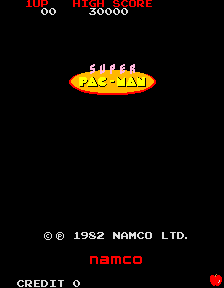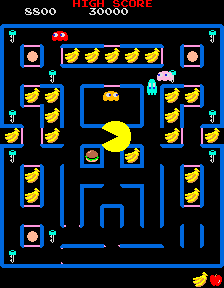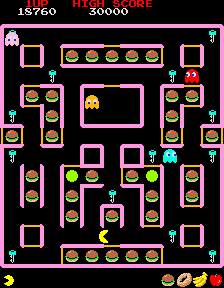

| Game: | Super Pac-Man |
| Developer: | |
| Publisher: | |
| Release Date: | August 11, 1982 in Japan & October 1,1982 in US. |
| Class: | Wide Release |
| Genre: | Maze |
| Gameplay: | Alternating |
| Simul. Players: | 1 |
| Max Players: | 2 |
| Monitor: | Vertically oriented, 288 x224, 16 palette colors |
| Joystick: | 4-way joystick & 1 button |
| Layout: | Bezel, Control Panel, PCB |
| Cabinet Type(s): | Standard upright; Mini-upright (Cabaret); Cocktail; |
| Cabinet Pics: | |
| Side Art: | |
| Boards: | |
| Arcade CPU: | M6809 |
| Sound: | M6809, Namco custom 8 channel 4-bit WSG. |
| Review Score: |  |
| Player Guide: | N/A |
| Cheats: | N/A |
 Super Pac-Man, released in 1982 and taking a slant on the legendary comic book hero Superman, is the third installment of the Pac-Man series of arcade games and the second starring Pac-Man himself. It is also the second game to be created by series originator Namco, as Ms. Pac-Man (the second in the series) was originally created without Namco’s involvement.
Super Pac-Man, released in 1982 and taking a slant on the legendary comic book hero Superman, is the third installment of the Pac-Man series of arcade games and the second starring Pac-Man himself. It is also the second game to be created by series originator Namco, as Ms. Pac-Man (the second in the series) was originally created without Namco’s involvement.
Characteristics and gameplay
Sound and gameplay mechanics were altered radically from the first two entries into the Pac-Man series – instead of eating dots, the player is required to eat keys in order to open doors, which open up sections of the maze that contain what in earlier games were known as “fruits” (foods such as apples and bananas, or other prizes such as Galaxian flagships), which are now the basic items that must be cleared. Once all the food is eaten, the player advances to the next level, in which the food is worth more points. In earlier levels, keys unlock nearby doors, while as the player progresses through the levels, it is more common for keys to open faraway doors.
In addition to the original power pellet which allows Pac-Man to eat the ghosts, an additional “Super” pellet was introduced which turns Pac-Man into Super Pac-Man – in this form, he is twice as large, moves much faster and has the ability to eat his way through barriers without unlocking them. In this state, he is invulnerable to the ghosts, though he still cannot eat them without the help of the original power-up. This game also adds a “speed” button, which allows Pac-Man to move faster when in “Super” mode.

| Item | Points |
| Key | 50 |
| Powerpill | 100 |
| Super Powerpill | 100 |
| Apple | 10 |
| Banana | 20 |
| Doughnut | 30 |
| Hamburger | 40 |
| Fried Egg | 50 |
| Corn Cob | 60 |
| Shoe | 70 |
| Cake Slice | 80 |
| Toadstool | 90 |
| Pineapple | 100 |
| Coffee Cup | 110 |
| Mushroom | 120 |
| Bell | 130 |
| 4-Leaf Clover | 140 |
| Galaxian | 150 |
| Present | 160 |
 Try to group the ghosts together, and lure as many as possible at once behind you before collecting a powerpill (3,000 for all 4 monsters).
Try to group the ghosts together, and lure as many as possible at once behind you before collecting a powerpill (3,000 for all 4 monsters).Note that you can kill the ghosts in their home, so on the early stages you can kill all 4, then collect another powerpill and kill them in their base as soon as they regenerate. This gives you another few seconds breathing space as well.
At the early parts of each level, concentrate on picking up as many keys as possible before collecting any treats. This way you open up a lot of the maze, saving grief later on.
When you are fully powered up, collecting a normal powerpill extends your powerup time. The super power does last longer than a normal powerpill.
When you are fully powered up, try and break through any remaining doors to save you from having to collect all the keys.
Don’t worry about the bonus star in the centre – it’s not worth wasting time waiting to try and match the items as you score far more points in general play on later levels.
Although the maze layout is always the same, the keys on later levels open different doors, so you can’t rely on the same patterns on each screen.
 * Based on the Namco Galaga hardware, this is the first of the Pac-Man games to use the Motorola 6809 processor, unlike the earlier Pac-Man games which used the older Z80, and fell into the “conversion class” of the Namco Galaxian. The new gameplay mechanics were considered by many to be confusing, and too much of a change from the original two games. In particular, when Pac-Man transforms into Super Pac-Man, he was thought by some to be much more difficult to control. Whatever the reason, Super Pac-Man proved to be the least successful game in the original series, being outsold that year by Pac-Man Plus, a slightly updated version of the original game, which, like the aforementioned Ms. Pac-Man, was produced by the American licensee Midway without authorization from developer Namco. Midway also went on to create Jr. Pac-Man, also based on the older Z80 processor, and having the basic sound and feel of the older games fans were more familiar with.
* Based on the Namco Galaga hardware, this is the first of the Pac-Man games to use the Motorola 6809 processor, unlike the earlier Pac-Man games which used the older Z80, and fell into the “conversion class” of the Namco Galaxian. The new gameplay mechanics were considered by many to be confusing, and too much of a change from the original two games. In particular, when Pac-Man transforms into Super Pac-Man, he was thought by some to be much more difficult to control. Whatever the reason, Super Pac-Man proved to be the least successful game in the original series, being outsold that year by Pac-Man Plus, a slightly updated version of the original game, which, like the aforementioned Ms. Pac-Man, was produced by the American licensee Midway without authorization from developer Namco. Midway also went on to create Jr. Pac-Man, also based on the older Z80 processor, and having the basic sound and feel of the older games fans were more familiar with.
In spite of this, the game’s A.I. was celebrated as being one of the best of that era.
 Super Pac-Man was only a moderate success in the 1980s as an arcade machine, and thus has not been as widely ported to home video game consoles as the original Pac-Man and Ms. Pac-Man. Still, the game has been revived several times.
Super Pac-Man was only a moderate success in the 1980s as an arcade machine, and thus has not been as widely ported to home video game consoles as the original Pac-Man and Ms. Pac-Man. Still, the game has been revived several times.
* In 1984, a port of Super Pac-Man was made for the Atari 5200 but was never released due to the big video game crash around that time.
* In 1988, DOS and Commodore 64 versions were released by Thunder Mountain.
* In 1996, It also appeared on the second Namco Museum arcade compilation for Sony’s PlayStation.
* In 1999, Super Pac-Man was included as a bonus feature on the Ms. Pac-Man cartridge for Nintendo’s Game Boy Color system.
* In 2006, Jakks Pacific released the Plug and Play Super Pac-Man joystick that contained Super Pac-Man along with Pac-Man, Pac-Man Plus, and Pac & Pal.
* Most recently, Namco has released a portable version on select cell phone models exclusively on Sprint.
As a promotional stunt, Sprint and Namco are running a sweepstakes offering the grand prize winner a Volkswagen New Beetle customized with Super Pac-Man art. The car was on display at major videogame tradeshow E3 in Los Angeles in May 2006. Super PAC-MAN Sweepstakes details
* In 2007, it was released for Palm PDA devices. Super Pac-Man at Handango a PDA software retailer.
 A Super Pac-Man unit appears in the 1983 movie Joysticks.
A Super Pac-Man unit appears in the 1983 movie Joysticks.
In the 1993 HBO film And the Band Played On, based on the book of the same name, Dr. Don Francis is inspired to take his research into AIDS in a new direction by watching a colleague play Super Pac-Man. (The Pac-Man character was compared to the human immunodeficiency virus, where Dr. Francis’ theory was that a virus would attack healthy cells.)
Super Pac-Man appeared in animated form during the second season of Hanna-Barbera’s animated Pac-Man series on ABC Saturday Morning in 1982. Here, he is portrayed as a separate character, and was voiced by Lorenzo Music. The character was a bit dopey, and basically lost control of his mouth, chomping everything in sight after eating a Super Power Pellet. This was evidently based on the difficulty of navigating Super Pac-Man in the game while the super speed button is pressed.
Super Pac-Man, along with Jr. Pac-Man, was scheduled to be released in cartridge form on the Atari 5200 video game console in 1984. Although both games were completed by the programmers, they were cancelled when Jack Tramiel’s holding company, Tramiel Technologies, Ltd., purchased Atari’s home consumer division from Warner Communications. They were unearthed in 2001 and introduced to the public at the 2001 Classic Gaming Expo.





